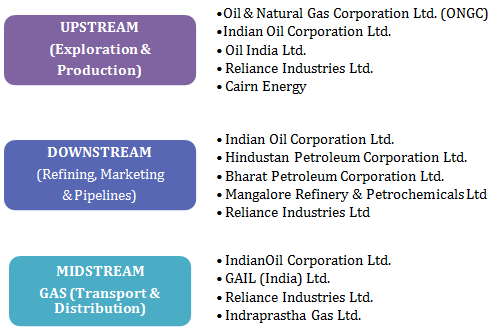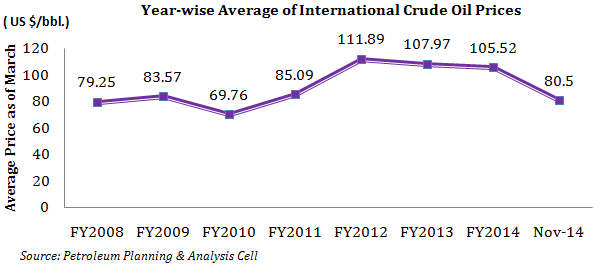The Oil and Gas Industry in India is one of the most important sectors and constitutes over 15 % of the GDP. In addition, it serves as the backbone for transportation and hence affects the performance of many other industries such as infrastructure, cement, construction etc. The oil and natural gas sector includes exploration, refining and marketing of petroleum products and gas. India is the fourth-largest consumer of oil and petroleum products in the world. According to Ministry of External Affairs, Govt. of India, energy demand is projected to touch 1,464 million tonnes of oil equivalent (Mtoe) by 2035 from 559 Mtoe in 2011. Furthermore, the country’s share in global primary energy consumption is anticipated to double by 2035. To cater to the increasing demand, the Government of India has adopted several policies; including 100 % foreign direct investment in many segments of the sector, such as natural gas, petroleum products, and refineries.
India has always been an import dependent nation as far as Oil & Natural Gas is concerned. India imports nearly three-fourths of its requirement of crude oil from the Middle East particularly from Saudi Arabia and Iraq. According to Ministry of Petroleum and Natural Gas, India has total reserves of 760 million metric tons of crude oil and 1330 billion cubic meters of natural gas as on April 1, 2012.
| Petroleum & Natural Gas Sector | Unit/Base | 2013-14 | September | |
| 2013 | 2014 | |||
| Crude Oil Production In India | MMT | 37.8 | 3.1 | 3.1 |
| Consumption of Petroleum Products | MMT | 158.2 | 12.0 | 12.3 |
| Production of Petroleum Products | MMT | 220.2 | 18.1 | 18.1 |
| Imports & Exports: | ||||
| Crude Oil Imports | $ Billion | 142.9 | 11.8 | 11.0 |
| Petroleum Products (POL) Imports | $ Billion | 12.3 | 1.1 | 1.1 |
| Gross Petroleum Imports (Crude + POL) | $ Billion | 155.2 | 12.9 | 12.1 |
| Petroleum Products Exports | $ Billion | 60.7 | 6.4 | 5.3 |
| Petroleum Imports as % of India’s Gross Imports | % | 34.4 | 37.6 | 28.0 |
| Petroleum Exports as % of India’s Gross Exports | % | 19.4 | 22.8 | 18.3 |
| Import Dependency (Based on Consumption) | % | 77.6% | 75.1 | 76.4 |
Major Players in the Oil and Natural Gas Sector in India
- Oil and Natural Gas Corporation Limited
- ONGC Videsh Limited
- Oil India Limited
- Reliance Industries Limited
- Cairn India Limited
- Essar Oil Limited
- Indian Oil Corporation Limited
- Bharat Petroleum Corporation Limited
- Hindustan Petroleum Corporation Limited
- GAIL (India) Limited
From an industry perspective, Oil & Natural Gas Industry is divided into two major sectors: upstream and downstream. In addition, for gas transportation and distribution companies there could be a further classification as midstream companies.
- Upstream companies are engaged in exploration and production of crude oil.
- Downstream companies are involved in refining of crude oil and the selling and distribution of natural gas and products derived from crude oil.
- Midstream companies process, store, market and transports commodities such as natural gas and natural gas liquids.
The oil and gas industry is dominated by state controlled enterprises with ONGC, the largest upstream company dominating the exploration & production segment and Indian Oil Corporation, the largest state controlled downstream company.
How are companies engaged in oil exploration & production paid?
Oil Exploration and Production (E&P) companies sell their crude oil to downstream refining and marketing companies based on international crude oil prices. Their revenue flow is directly related to the international prices. Thus lower prices are negative for exploration and production (E&P) companies. Their revenues will immediately take a hit if the oil price continues to fall. Below chart depicts the pattern of year-wise average of international crude oil prices.
Factors to watch out for before investing in the oil and gas sector
- A very personal view – Focus on companies that have made investments in exploration projects – these will be hugely profitable in the long run.
- Pay attention to government pricing policies – They are the single most important criteria when it comes to an impact on the revenue and profitability of oil & gas companies. Recent reforms in the sector includes:
i. Diesel price deregulation: Just like petrol, diesel prices will now be linked to the international market rates rather than being controlled by the government. This will help the government lower its spending on subsidies by bridging the gap between global and domestic market prices.
Diesel price deregulation is also positive for state-owned downstream oil marketing companies (OMC) such as Indian Oil Corporation Limited, Bharat Petroleum Corporation Limited and Hindustan Petroleum Corporation Limited because they will no longer incur losses arising from any shortfalls between the government-set sale price of diesel and production costs (i.e., under-recoveries, which is the loss that OMCs make by selling fuels at prices set by the government). This will be a positive move for state-owned upstream producers also like ONGC and Oil India because it reduces the fuel subsidy burden they share with the government.
ii. Gas Price hike to $5.60 per million British thermal units (mmbtu) from the current $4.20/mmbtu. This will help upstream companies like ONGC and Oil India to benefit from an increase in revenues. Although the new price falls short of expectations and we believe that a further revision is likely to happen soon.
- Global supply, especially from OPEC countries, is another factor. Reduction in supply increases prices of crude oil and reduces the revenue of oil companies.
Big players in the Oil and Gas Sector in India
(Rs. Cr)
| Company | Cairn India | ONGC | IOCL | Oil India |
| Total Income from Operation | 18,761.70 | 1,74,466.56 | 4,88,344.93 | 9,715.71 |
| EBITDA | 13,685.72 | 49,718.70 | 17,056.54 | 4,108.05 |
| Profit After Tax | 12,431.79 | 26,506.53 | 7,085.59 | 2,941.98 |
| Reserves | 55,530.06 | 167,873.23 | 65,485.07 | 19,880.64 |
| P/E | 4.73 | 16.58 | 17.81 | 10.69 |
Segmental Revenue Representation of Major Oil & Gas Companies in India
(click to enlarge)






why most of the time we does not invest in oil and gas sector?
Why dont you?
I am a student and I want to invest in gas and oil sector monthly ,may be 2000 Rupees,is their any way to start ,And if yes,let me know.
Yes. But stocks of top 5 companies each month.